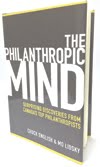Scott’s blog references a study on choice saturation conducted at the University of Minnesota and offers this quote from one of the researchers. “While mulling over a few options may weigh heavily on your mind, finally choosing one may just plain wear you out.” The study’s conclusion was that the simple act of choosing caused mental fatigue.
There is something that intuitively rings true about these findings. Too many of us have had a moment in the cereal aisle or staring at the fast food menu or ordering coffee or roaming the aisles of our local video store. And what happens when it’s something we’re not committed to buying. Does “choice anxiety” actually get in the way of making a sale? Maybe less is more powerful when it comes to choices.
We offer prospective donors the option of annual funds, endowment funds, capital campaigns, planned giving (with all its options) and various individual projects to support. And while the notion of allowing donors to find the giving opportunity that is most meaningful remains sound, perhaps it's all a little overwhelming. We need to find a way to capitalize on the donor's interest while not driving them away with too many choices. Here’s a couple of ways that you may be able to bridge the gap:
- Create a simple, uncluttered landing page for the ‘Support” section of your website that presents a very compelling (which means very visual) and succinct case for giving and offers the donor only two choices. One is “I would like to support ABC organization. Please contact me.” The second is “click here to discover the many ways you can support ABC Organization.” The second option would take donors to the full “Support” section.
- Create a campaign that has only one available donation amount. Make it an amount that is accessible to a broad range of supporters and make the ask very simple. Yes, you may leave some money on the table but if through its simplicity, the campaign allows you to connect with new donors, it’s a success.
There are lots of other ways of using this approach but in keeping with the subject matter I certainly didn’t want to offer too many choices.
Maybe the “simple” mode is a way of zigging while everyone else zags and cutting through all the clutter that confronts donors.





